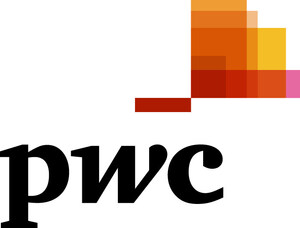NEW YORK, June 22, 2011 /PRNewswire/ -- Despite a skittish U.S. economy, most commercial real estate investors remain upbeat and cautiously optimistic about the industry's future, with very few being dissuaded from eagerly acquiring assets and seeking opportunities across all commercial real estate sectors. In fact, many investors are aggressively pursuing deals as they continue to see signs that the industry's overall fundamentals are stabilizing and even improving in certain sectors and regions, according to the second quarter 2011 findings of the PwC Real Estate Investor Survey, released today.
(Logo: http://photos.prnewswire.com/prnh/20100917/NY66894LOGO )
According to the report, rental rates remain below peak levels for most property types and regions, although there is a sense among surveyed investors that they have stabilized. This quarter, the average market rent change rate assumption reported by Survey investors increased in 25 of the report's 31 markets, further demonstrating investors' sense that an ongoing, albeit slow, recovery is occurring.
"The trajectory of the commercial real estate industry's recovery is largely dependent on the health of the U.S. economy. The ability of the economy to add jobs instills optimism in both businesses and consumers," said Mitch Roschelle, partner, U.S. real estate advisory practice leader, PwC. "Despite recent disappointing labor reports and falling home prices, commercial real estate investors continue to look to the positive aspects of the industry as they remain cautiously optimistic that the recovery path will continue. The significant lack of new supply over the past several years serves as the catalyst of the ongoing recovery. As tenant demand continues to grow, positive absorption has begun to drive rents up. The prospects of rent growth have driven much of the aggressive bidding by investors in certain top-performing markets."
"In addition to improving fundamentals, the volatility of the stock market, weakening currencies, and the low fixed income coupons have fueled a rotation into hard assets such as precious metals, commodities and commercial real estate," Roschelle added. Most institutional investors, particularly pension funds, are targeting top-performing assets in strong markets with some surveyed participants indicating that they're concentrating on opportunistic plays. Moreover, there are a growing number of distressed assets that are trading as bank regulators put more pressure on lenders to deal with nonperforming loans – yet another sign that the U.S. commercial real estate industry is on the mend.
Office Sector Leads Quarterly Overall Cap Rate Decline
The average overall capitalization (cap) rate, the initial return anticipated on an acquisition and a reflection of an investment's anticipated ownership risk, decreased in 27 of the 31 surveyed markets, increased in three, and held steady in one during the second quarter 2011. The steepest declines occurred for the national central business district (CBD) and national suburban office markets, as well as the Dallas office market, where the average declined 51 basis points.
While the apartment sector has led the industry's recovery and has experienced continued cap rate compression over the past 18 months, the office sector was slow to rebound due to a sluggish labor market. However, as employment has improved and business profits have risen, the sector has gained traction and, as a result, more investors are focused on acquiring office buildings, causing overall cap rates to decline – especially for core assets in top markets. Over the next six months, the Survey found that participants expect overall cap rates to either hold steady or decline due to strong buyer interest, low interest rates, and a positive economic outlook.
According to Survey findings, the Manhattan office market's average overall cap rate has fallen below 6.00 percent for the first time since 2008 and represents the lowest average of the 18 individual office markets in the Survey, reflecting investors' confidence in Manhattan's ability to lead the recovery and rebound faster and stronger than most other metro areas. An optimistic outlook for Manhattan is also reflected when reviewing the Survey's average market rent change rate assumptions, or what investors foresee rental rates increasing by over the next year. When comparing this key indicator for the Manhattan office market to the Survey's national CBD office market, it is clear that investors in Manhattan were quite aggressive with their rent expectations during the expansion, but became very pessimistic during the recession.
Investors are back on track with pre-recession growth expectations for Manhattan, as well as the national CBD market. As shown in the accompanying chart, average market rent change rate assumptions in the Manhattan office market have steadily climbed back since the lowest point during the recession in third quarter 2009, when it was hovering around -6.50 percent, up to 3.00 percent in the second quarter 2011. The national CBD office market, which was at -2.00 percent in fourth quarter 2009, is now at 1.39 percent. These trends support the notion that investor sentiment is improving in CBD cores, especially top-performing markets.
Market Rent Growth Expectations: Second Quarter 1996 thru Second Quarter 2011
(Photo: http://photos.prnewswire.com/prnh/20110622/NY22896 )
Source: PwC US
"Surveyed investors are treading carefully as they realize that troubles could arise if interest rates rapidly increase at the same time and a large pool of commercial maturities peaks over the next two years," stated Susan Smith, editor-in-chief of PwC's quarterly survey. "If those factors play out, overall cap rates would likely rise and negatively impact property values. Luckily, though, most of the participants have told us that they maintain an optimistic outlook for now, even if cautiously so."
Anticipated Performance for Each Sector
The PwC Real Estate Barometer that's included within the Survey tracks the anticipated performances of the four main property sectors (office, retail, industrial, and multifamily) from 2011 to 2014. According to the barometer, 62.4 percent of the U.S. office stock will be in recovery mode by year-end 2011; in 2012, this percentage will decline a bit as a greater portion of stock enters the expansion phase. For the U.S. retail sector, the majority will be in recession through year-end 2012. Although the amount of stock in recession will decline greatly by year-end 2013, a significant recovery is not expected until year-end 2014.
The U.S. industrial market has been helped out by improvements in manufacturing, capital goods shipments, and business and consumer spending. Overall vacancy is declining in the sector and a recovery is underway for many cities. As a result, the portion of U.S. industrial stock in recovery is expected to surge over the next 15 months.
The barometer shows that the best-performing sector in the industry is the U.S. multifamily market, which is dominated by the recovery phase of the real estate cycle and is segueing more and more into the expansion phase annually through 2014. In fact, not one of the 81 multifamily metro areas included in the barometer will be in recession over the next four years.
Information about subscribing to the PwC Real Estate Investor Survey can be found at www.pwc.com/us/realestatesurvey. Members of the media can obtain an electronic copy of the full report by contacting Scott Cianciulli at (212) 986-6667 or [email protected].
About the PwC Real Estate Investor Survey™
The PwC Real Estate Investor Survey, now in its 24th year of publication, is one of the industry's longest continuously produced quarterly surveys. The current report provides overviews of 31 separate markets, including ten national markets -- regional mall, power center, strip shopping center, CBD office, suburban office, flex/R&D, warehouse, apartment, net lease, and medical office buildings. The report also includes a review of 18 major U.S. office markets including Atlanta, Boston, Charlotte, Chicago, Dallas, Denver, Houston, Los Angeles, Manhattan, Northern Virginia, Pacific Northwest, Philadelphia, Phoenix, San Diego, San Francisco, Southeast Florida, Suburban Maryland, and Washington, DC. In addition, the report covers three regional apartment markets - - Mid-Atlantic, Pacific, and Southeast.
The second quarter 2011 report also features up-to-date information relating to forecast periods, structural vacancy replacement reserves, forecast values, tenant improvement allowances, and vacancy assumptions. In addition, each issue of the Survey contains over ten tables of market data focusing on value expectations, tenant improvement allowances, forecast periods, structural vacancy, and growth rates. Also in this issue is the semiannual National Development Land Market.
About the PwC Network
PwC firms provide industry-focused assurance, tax and advisory services to enhance value for their clients. More than 161,000 people in 154 countries in firms across the PwC network share their thinking, experience and solutions to develop fresh perspectives and practical advice. See www.pwc.com for more information.
© 2011 PwC. All rights reserved. "PwC" and "PwC US" refer to PricewaterhouseCoopers LLP, a Delaware limited liability partnership, which is a member firm of PricewaterhouseCoopers International Limited, each member firm of which is a separate legal entity. This document is for general information purposes only, and should not be used as a substitute for consultation with professional advisors.
SOURCE PwC
WANT YOUR COMPANY'S NEWS FEATURED ON PRNEWSWIRE.COM?
Newsrooms &
Influencers
Digital Media
Outlets
Journalists
Opted In





Share this article